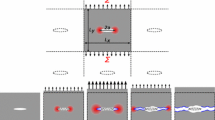Abstract
Recent experiments by Robertson show that the fracture toughness G IC of glassy polystyrene PS does not decrease to the ideal brittle value 2γ (where γ is the surface energy for PS) at molecular weights M w below M c the entanglement molecular weight. Instead G IC is more than an order of magnitude above 2γ at M c and decreases slowly below M c. It is postulated that a small craze exists at the crack tip in such low molecular weight glassy polymers. However, since entanglements do not occur single molecules must span this craze; if they do not the craze becomes unstable and the crack advances. Under these conditions a critical craze surface displacement exists and G C can be computed to be G IC=S c(λ−1) 〈R 2〉1/2, where λ and S c are the craze fibril extension ratio and craze surface drawing stress observed in high molecular weight crazes (both quantities should be only weak functions of M w) and 〈R 2〉1/2 is the root mean square end-to-end distance of the PS molecule in the glass from neutron scattering measurements. The fracture toughness is predicted to decrease as M 1/2w ; this prediction and the absolute magnitude of G IC are in excellent agreement with experiment.
Similar content being viewed by others
References
G. T. Hahn, M. F. Kanninen and A. R. Rosenfield, Ann. Rev. Mater. Sci. 2 (1972) 381.
G. I. Barenblatt, Adv. Appl. Mech. 7 (1962) 55.
A. A. Griffith, Phil. Trans. Roy. Soc. A221 (1920) 163.
G. T. Hahn and A. R. Rosenfield, in “Applications Related Phenomena in Titanium Alloys”, ASTM STP 432 (American Society for Testing and Materials, Philadelphia, 1968) p. 5.
Idem, Met. Trans. 6A (1975) 653.
R. Thomson, J. Mater. Sci. 13 (1978) 128.
L. C. Cessna Jr and S. S. Sternstein, Polymer Letters 3 (1965) 825.
Idem, in “Fundamental Phenomena in the Materials Sciences”, edited by L. J. Bovis, J. J. Duga and J. J. Gilman, Vol. 4 (Plenum Press, New York, 1967) p. 45.
H. R. Brown and I. M. Ward, Polymer 14 (1973) 469.
G. P. Morgan and I. M. Ward, ibid 18 (1977) 87.
R. A. W. Fraser and I. M. Ward, ibid 19 (1978) 220.
N. J. Mills and N. Walker, ibid 17 (1976) 439.
J. G. Williams and G. P. Marshall, Proc. Roy. Soc. Lond. A342 (1975) 55.
E. H. Andrews and L. Bevan, Polymer 13 (1972) 337.
I. N. Sneddon, “Fourier Transforms” (McGraw Hill, New York, 1951) pp. 395–430.
A. C. Knight, J. Polymer Sci. A3 (1965) 1845.
E. J. Kramer, H. G. Krenz and D. G. Ast, J. Polymer Sci. Polymer Phys. 16 (1978) 349.
E. J. Kramer, in “Developments in Polymer Fracture”, edited by E. H. Andrews (Applied Sciences Publishers, London, 1979).
B. D. Lauterwasser and E. J. Kramer, Phil. Mag. (in press).
R. S. Porter and J. F. Johnson, Chem. Rev. 66 (1966) 1.
P. G. De Gennes, J. Chem. Phys. 55 (1971) 572.
Idem, Macromol. 9 (1976) 587.
A. N. Gent and A. G. Thomas, J. Polymer Sci. A2 10 (1972) 571.
R. P. Kusy and D. T. Turner, Polymer 15 (1974) 394.
R. E. Robertson, in “ACS Symposium on Toughness and Brittleness of Plastics”, September 1974, edited by R. D. Denin and A. D. Crugnola, Adv. in Chemistry Series no. 154, (ACS, New York, 1976) p. 89.
J. F. Fellers and B. F. Kee, J. Appl. Polymer Sci. 18 (1974) 2355.
T. E. Brady and G. S. Y. Yeh, J. Mater. Sci. 8 (1973) 1083.
S. Wellinghoff and E. Baer, J. Macromol. Sci. Phys. B11 (1975) 367.
D. L. G. Lainchbury and M. Bevis, J. Mater. Sci. 11 (1976) 2222.
R. N. Haward, H. E. Daniels and L. R. G. Treloar, J. Polymer Sci. Polymer Phys. 16 (1978) 1169.
R. G. Kirste, W. A. Kruse and J. Schelten, Macromol. Chem. 162 (1972) 199.
H. Benoit, D. Decker, J. S. Higgins, C. Picot, J. P. Cotton, B. Farnoux, G. Jannick and R. Ober, Nature Phys. Sci. 245 (1973) 13.
G. D. Wignall, D. G. H. Ballard and J. Schelten, J. Macromol. Sci. Phys. B12 (1976) 75.
D. S. Dugdale, J. Mech. Solids 8 (1960) 100.
J. N. Goodier and F. A. Field, “Proceedings of the International Conference on Fracture of Solids”, edited by D. C. Drucker and J. J. Gilman, Met. Soc. Conferences, Vol. 20 (Interscience, New York, 1963) p. 103.
Author information
Authors and Affiliations
Rights and permissions
About this article
Cite this article
Kramer, E.J. A molecular theory of the fracture toughness of low molecular weight polymers. J Mater Sci 14, 1381–1388 (1979). https://doi.org/10.1007/BF00549312
Received:
Accepted:
Issue Date:
DOI: https://doi.org/10.1007/BF00549312




